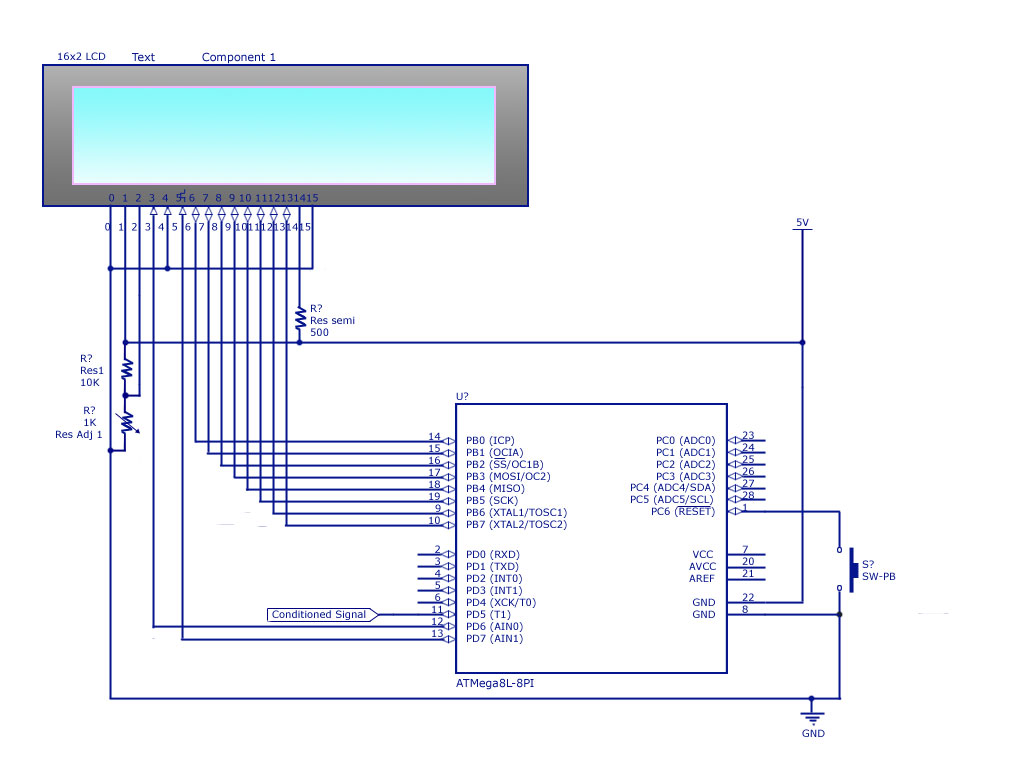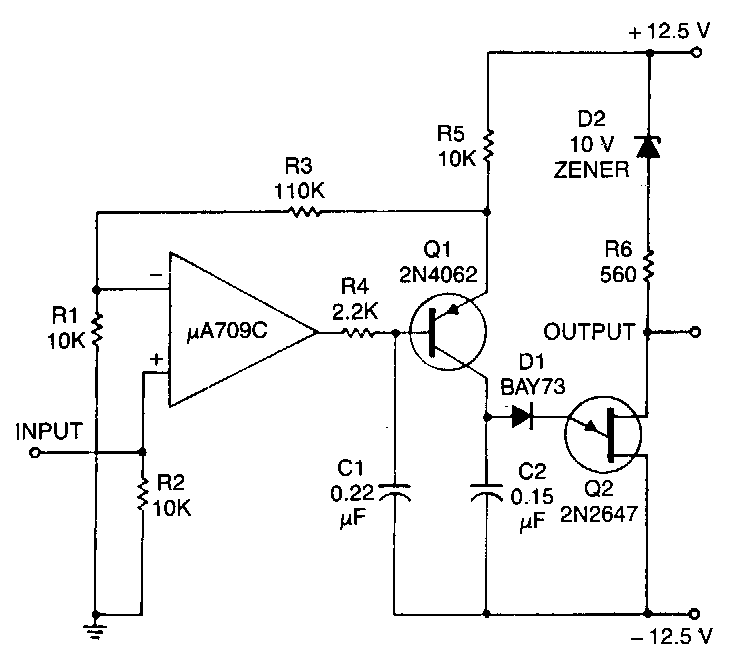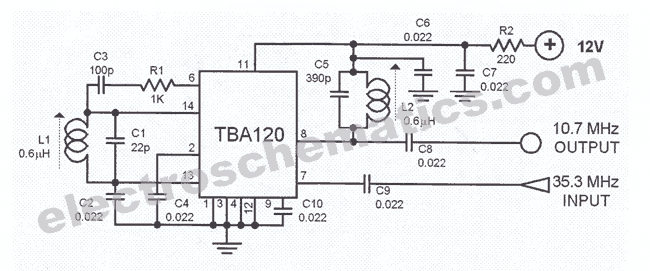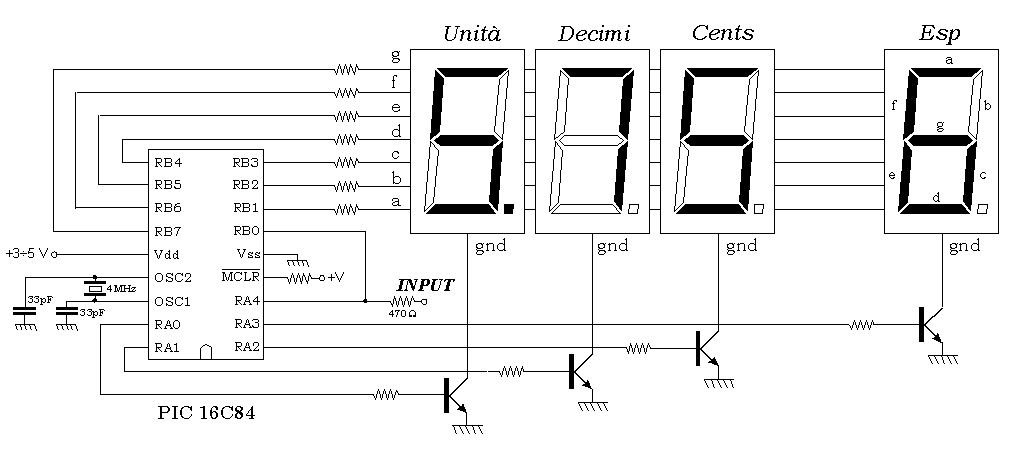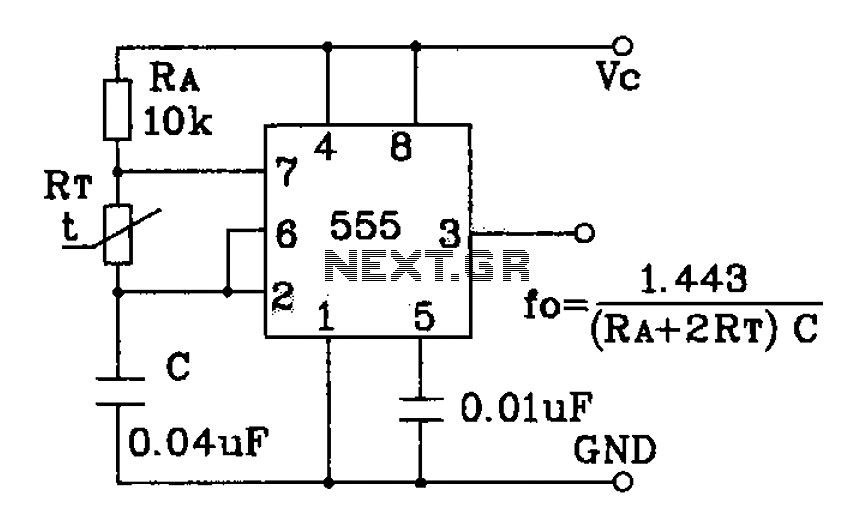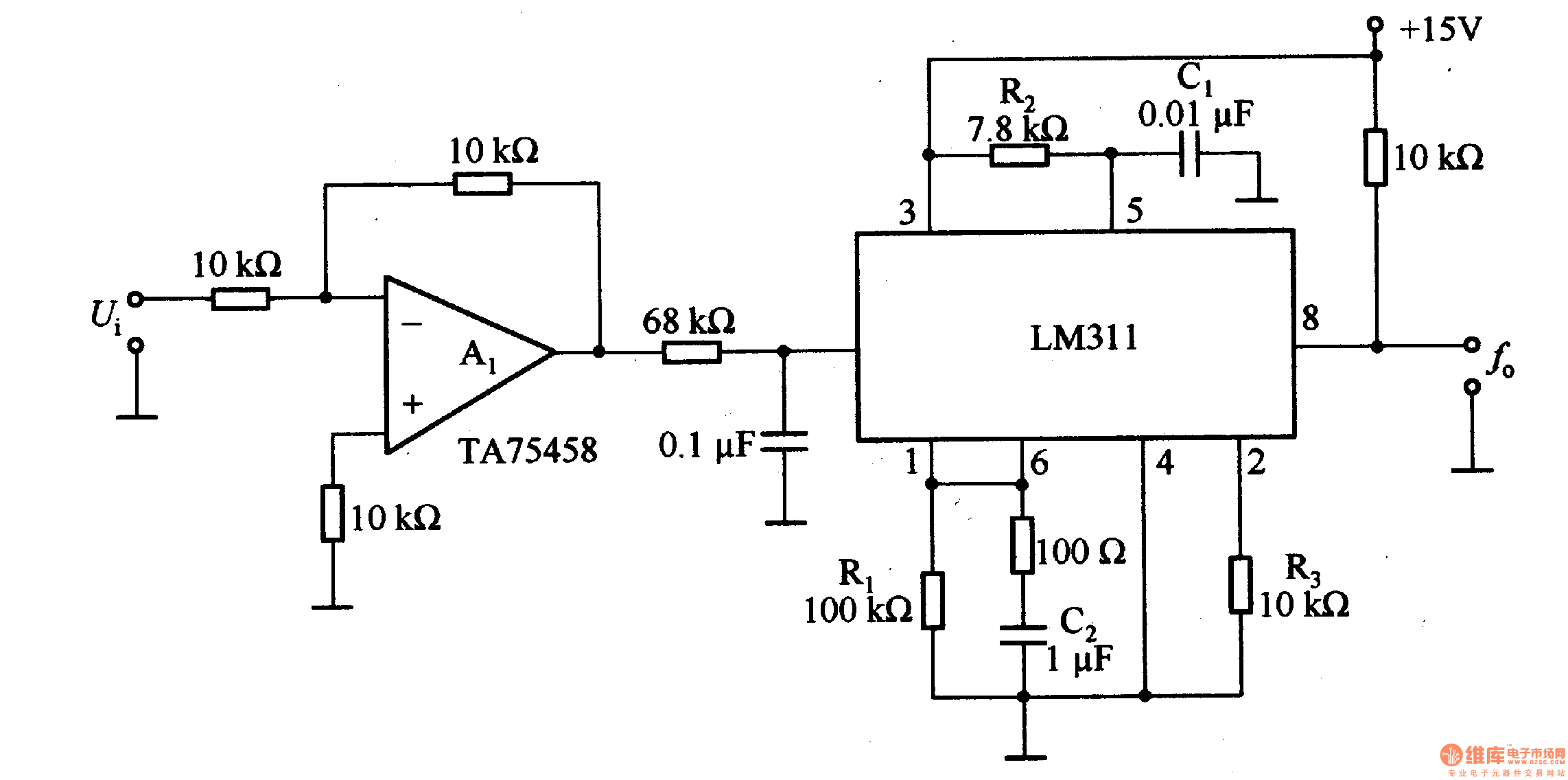
Adjustable High/Low Frequency Sine wave generators
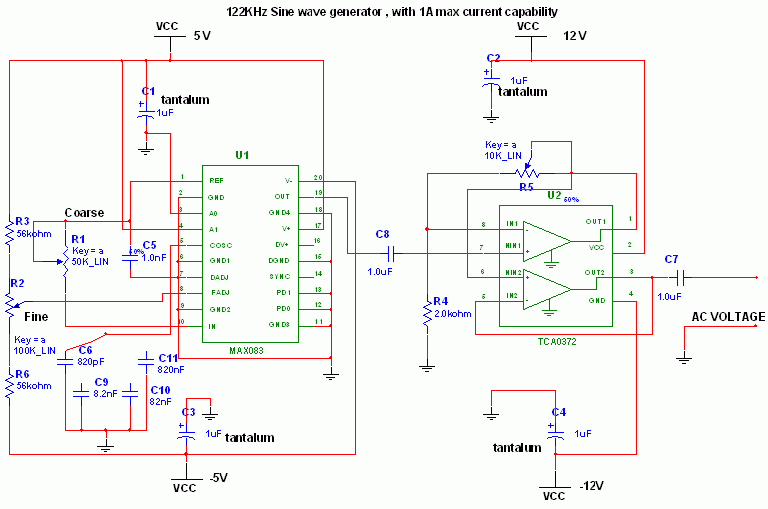
This circuit utilizes the versatile MAX038 function generator. While some advanced features of this IC are disabled in this configuration, it is capable of generating sine, triangle, and square waves by adjusting the A0 and A1 pins (refer to the datasheet for additional waveforms with a switch). A frequency of 122 kHz was selected for this application to create an ESR meter for monitoring the health of electrolytic capacitors, which must discharge tens of amperes in less than 2 ms. At 122 kHz, the capacitive reactance is minimal, and the inductive reactance is not significantly high, allowing for a current (e.g., 200 mA, using a precision resistor) to flow through a capacitor while measuring the AC voltage drop across it to estimate the equivalent series resistance (ESR) using the formula Vdrop/current. Although inductive and capacitive reactance are present, they are negligible. The MAX038 IC generates a 122 kHz, 2V peak-to-peak sine wave, with the frequency calculated by the formula Freq (MHz) = Iin (µA) / C6 (pF). Here, Iin = 2.5V / R1 (25 kΩ default), resulting in a frequency of 0.122 MHz. The resistor allows for minor adjustments; values should not go below 10 kΩ or above 40 kΩ to maintain accuracy. For multi-frequency generation, a multiposition switch can be employed with capacitors of 820 pF, 8.2 nF, 82 nF, and 820 nF for the 122 kHz range, as well as for 12.2 kHz, 1.22 kHz, and 122 Hz ranges. Fine-tuning is achievable by adjusting R2, with frequency variations from 1.7x (Vfadj = -2.4) to 0.3x (Vfadj = 2.4) of the main frequency when fadj is at 0V. The sine wave output is fed into a TCA0372 op-amp configured as a non-inverting amplifier to achieve a gain ranging from 1 to 5 (2V peak-to-peak to 10V peak-to-peak), with adjustments made using a potentiometer, followed by a buffer stage using another TCA0372 op-amp. Frequency adjustments necessitate the use of a frequency counter, so this circuit should be operated in conjunction with one. Although the maximum current is 1A, it is advisable not to exceed 0.5A for maintaining accuracy. The circuit requires a computer power supply providing 12V, 5V, -5V, -12V, and GND. Alternatively, a multivoltage mains transformer (15 watts is sufficient) can be used alongside diode bridges (rated for low current, 1-2 Amps), smoothing capacitors of 10,000 µF at 16V, and voltage regulators such as the LM7905 and LM7912.
The MAX038 function generator is a highly capable integrated circuit that allows for the generation of various waveforms with precise frequency control. In this specific application, the circuit's design emphasizes the importance of monitoring the ESR of electrolytic capacitors, which can be critical in ensuring the reliability of electronic devices. The choice of 122 kHz is strategic, as it keeps reactance low, facilitating accurate ESR measurements.
The use of a precision resistor for current measurement ensures that the voltage drop across the capacitor can be accurately interpreted in relation to the current flowing through it. This relationship is fundamental for calculating ESR, which is a key parameter in assessing capacitor health. The design allows for flexibility in frequency generation through the use of a multiposition switch, which can accommodate a variety of capacitor values, thus enabling the user to select the desired frequency range easily.
The TCA0372 op-amps play a crucial role in amplifying the output signal from the MAX038, providing the necessary gain to make the measurements more discernible. The buffer stage ensures that the output signal remains stable and is not affected by subsequent circuit loading.
For operational stability, the circuit's power supply requirements are well-defined, emphasizing the need for multiple voltage levels to support the different components effectively. The inclusion of smoothing capacitors and voltage regulators ensures that the circuit operates within specified voltage ranges, which is essential for maintaining performance and accuracy.
This circuit exemplifies a practical application of function generators in electronic testing and diagnostics, demonstrating how integrated circuits can be utilized to create effective measurement tools in the field of electronics.This circuit uses the versatile MAX038 function generator. Although in this circuit some of the advanced characteristics of this IC are disabled, you can generate Sine, Triangle, Square waves (adjusting A0 and A1 pins see datasheet on if you want other waves, use a switch). I selected this particular frequency (122 Khz) because i needed a cheapo ESR-o-meter for my electrolytic capacitors to monitor their health as they have to discharge tens of amperes in less than 2 ms. At 122 KHz capacitive reactance is very low, and inductive reactance isn`t so high, so forcing a current (es 200mA, using a precision resistor) through a capacitor and reading AC voltage drop accross it gives me an estimation of ESR (Vdrop/current).
Of course inductive and capacitive reactance are still present, but negligible. The 122 khz 2V p-p sine wave is generated by the MAX038 IC, its frequency can be calculated by the formula Freq (MHz) = Iin(uA) / C6 (pf). Iin = 2, 5V / R1 (25Kohm default). So the freq is 0, 122 MHz. The resistor is for small adjustments, don`t go under 10000 Kohm or above 40000 Kohm because the accuracy will drop.
If you want multifrequency just use the multiposition switch with 820 pF, 8, 2 nF, 82nF, 820 nf for 122Khz range 12, 2Khz range 1220 Hz and 122 Hz. Fine tuning can be done adjusting R2, the frequency can vary from 1, 7x (Vfadj = -2, 4) to 0, 3x (Vfadj = 2, 4) of the main frequency (when fadj is at 0V).
The sine wave output is feed into a TCA0372 1/2 opamp to achieve a gain from 1 to 5 (2V p-p, 10 V p-p), adjust the potenziometer and into a TCA0372 2/2 opamp buffer stage also present on the same IC. Adjusting the frequency needs a frequency counter, so this circuit should be used on conjunction with a freq couter.
The max current is 1A, but i would suggesto to not go above 0, 5A to remain accurate. Needs a computer power supply with 12V, 5V, -5V, -12V, GND to be operated, if you don`t have one just use a multivoltage mains transformer (15 watt is enough) diode bridges (low current 1-2 Amps), smoothing capacitors 10000uF 16V, and voltage regulators such as LM7905 and LM7912. 🔗 External reference
The MAX038 function generator is a highly capable integrated circuit that allows for the generation of various waveforms with precise frequency control. In this specific application, the circuit's design emphasizes the importance of monitoring the ESR of electrolytic capacitors, which can be critical in ensuring the reliability of electronic devices. The choice of 122 kHz is strategic, as it keeps reactance low, facilitating accurate ESR measurements.
The use of a precision resistor for current measurement ensures that the voltage drop across the capacitor can be accurately interpreted in relation to the current flowing through it. This relationship is fundamental for calculating ESR, which is a key parameter in assessing capacitor health. The design allows for flexibility in frequency generation through the use of a multiposition switch, which can accommodate a variety of capacitor values, thus enabling the user to select the desired frequency range easily.
The TCA0372 op-amps play a crucial role in amplifying the output signal from the MAX038, providing the necessary gain to make the measurements more discernible. The buffer stage ensures that the output signal remains stable and is not affected by subsequent circuit loading.
For operational stability, the circuit's power supply requirements are well-defined, emphasizing the need for multiple voltage levels to support the different components effectively. The inclusion of smoothing capacitors and voltage regulators ensures that the circuit operates within specified voltage ranges, which is essential for maintaining performance and accuracy.
This circuit exemplifies a practical application of function generators in electronic testing and diagnostics, demonstrating how integrated circuits can be utilized to create effective measurement tools in the field of electronics.This circuit uses the versatile MAX038 function generator. Although in this circuit some of the advanced characteristics of this IC are disabled, you can generate Sine, Triangle, Square waves (adjusting A0 and A1 pins see datasheet on if you want other waves, use a switch). I selected this particular frequency (122 Khz) because i needed a cheapo ESR-o-meter for my electrolytic capacitors to monitor their health as they have to discharge tens of amperes in less than 2 ms. At 122 KHz capacitive reactance is very low, and inductive reactance isn`t so high, so forcing a current (es 200mA, using a precision resistor) through a capacitor and reading AC voltage drop accross it gives me an estimation of ESR (Vdrop/current).
Of course inductive and capacitive reactance are still present, but negligible. The 122 khz 2V p-p sine wave is generated by the MAX038 IC, its frequency can be calculated by the formula Freq (MHz) = Iin(uA) / C6 (pf). Iin = 2, 5V / R1 (25Kohm default). So the freq is 0, 122 MHz. The resistor is for small adjustments, don`t go under 10000 Kohm or above 40000 Kohm because the accuracy will drop.
If you want multifrequency just use the multiposition switch with 820 pF, 8, 2 nF, 82nF, 820 nf for 122Khz range 12, 2Khz range 1220 Hz and 122 Hz. Fine tuning can be done adjusting R2, the frequency can vary from 1, 7x (Vfadj = -2, 4) to 0, 3x (Vfadj = 2, 4) of the main frequency (when fadj is at 0V).
The sine wave output is feed into a TCA0372 1/2 opamp to achieve a gain from 1 to 5 (2V p-p, 10 V p-p), adjust the potenziometer and into a TCA0372 2/2 opamp buffer stage also present on the same IC. Adjusting the frequency needs a frequency counter, so this circuit should be used on conjunction with a freq couter.
The max current is 1A, but i would suggesto to not go above 0, 5A to remain accurate. Needs a computer power supply with 12V, 5V, -5V, -12V, GND to be operated, if you don`t have one just use a multivoltage mains transformer (15 watt is enough) diode bridges (low current 1-2 Amps), smoothing capacitors 10000uF 16V, and voltage regulators such as LM7905 and LM7912. 🔗 External reference
